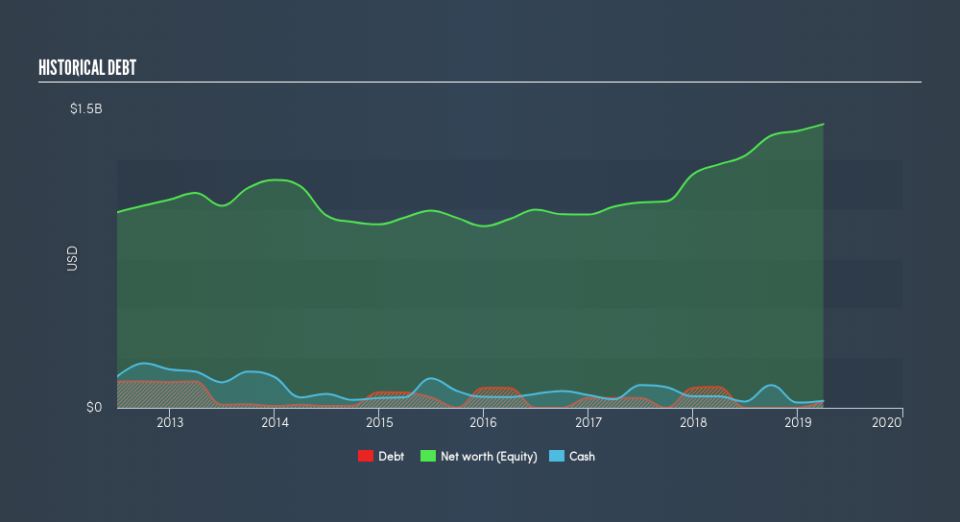Is Jack Henry & Associates, Inc. (NASDAQ:JKHY) As Strong As Its Balance Sheet Indicates?

Want to participate in a short research study? Help shape the future of investing tools and you could win a $250 gift card!
With a market capitalization of US$11b, Jack Henry & Associates, Inc. (NASDAQ:JKHY) is a large-cap stock, which is considered by most investors as a safe bet. Common characteristics for these big stocks are their strong balance sheet and high liquidity, which means there's plenty of stocks available to the public for trading. These companies are resilient in times of low liquidity and are not as strongly impacted by interest rate hikes as companies with lots of debt. Using the most recent data for JKHY, I will determine its financial status based on its solvency and liquidity, and assess whether the stock is a safe investment.
View our latest analysis for Jack Henry & Associates
Does JKHY Produce Much Cash Relative To Its Debt?
JKHY has shrunk its total debt levels in the last twelve months, from US$105m to US$35m , which also accounts for long term debt. With this debt payback, the current cash and short-term investment levels stands at US$35m to keep the business going. Moreover, JKHY has generated cash from operations of US$411m over the same time period, leading to an operating cash to total debt ratio of 1173%, signalling that JKHY’s debt is appropriately covered by operating cash.
Can JKHY pay its short-term liabilities?
At the current liabilities level of US$331m, it appears that the company has been able to meet these commitments with a current assets level of US$389m, leading to a 1.17x current account ratio. The current ratio is the number you get when you divide current assets by current liabilities. For IT companies, this ratio is within a sensible range since there is a bit of a cash buffer without leaving too much capital in a low-return environment.
Is JKHY’s debt level acceptable?
What is considered a high debt-to-equity ratio differs depending on the industry, because some industries tend to utilize more debt financing than others. As a rule of thumb, a financially healthy large-cap should have a ratio less than 40%. With a debt-to-equity ratio of 2.5%, JKHY's debt level is relatively low. JKHY is not taking on too much debt commitment, which may be constraining for future growth. We can check to see whether JKHY is able to meet its debt obligations by looking at the net interest coverage ratio. Ideally, earnings before interest and tax (EBIT) should cover net interest by at least three times. For JKHY, the ratio of 935x suggests that interest is comfortably covered. High interest coverage is seen as a responsible and safe practice, which highlights why most investors believe large-caps such as JKHY is a safe investment.
Next Steps:
JKHY’s high cash coverage and low debt levels indicate its ability to utilise its borrowings efficiently in order to generate ample cash flow. In addition to this, the company exhibits proper management of current assets and upcoming liabilities. I admit this is a fairly basic analysis for JKHY's financial health. Other important fundamentals need to be considered alongside. I recommend you continue to research Jack Henry & Associates to get a more holistic view of the stock by looking at:
Future Outlook: What are well-informed industry analysts predicting for JKHY’s future growth? Take a look at our free research report of analyst consensus for JKHY’s outlook.
Valuation: What is JKHY worth today? Is the stock undervalued, even when its growth outlook is factored into its intrinsic value? The intrinsic value infographic in our free research report helps visualize whether JKHY is currently mispriced by the market.
Other High-Performing Stocks: Are there other stocks that provide better prospects with proven track records? Explore our free list of these great stocks here.
We aim to bring you long-term focused research analysis driven by fundamental data. Note that our analysis may not factor in the latest price-sensitive company announcements or qualitative material.
If you spot an error that warrants correction, please contact the editor at editorial-team@simplywallst.com. This article by Simply Wall St is general in nature. It does not constitute a recommendation to buy or sell any stock, and does not take account of your objectives, or your financial situation. Simply Wall St has no position in the stocks mentioned. Thank you for reading.


